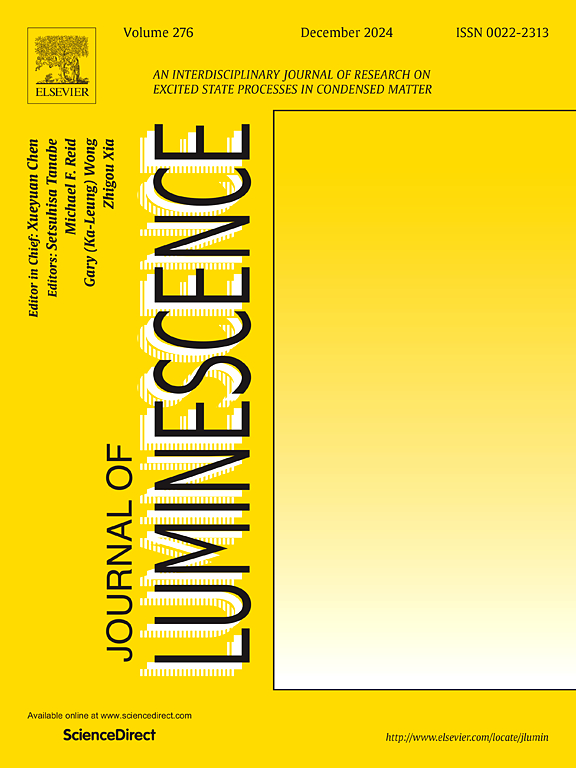掺te硼酸钡玻璃在gc-LED器件中的宽带近红外发光研究
IF 3.3
3区 物理与天体物理
Q2 OPTICS
引用次数: 0
摘要
研制了掺碲团簇的强近红外荧光硼酸盐玻璃,并对其光谱特性进行了研究。在氧化气氛下,Te团簇不能形成;然而,在还原气氛下,成功地实现了覆盖600-1400 nm的宽带te簇近红外发射,其峰中心位于900 nm,半峰全宽(FWHM)为270 nm。结果表明,调整玻璃成分和TeO2掺杂浓度可以显著增强掺te硼酸盐玻璃的近红外发射。此外,研究表明,该材料的光致发光性能对温度和激发波长都高度敏感,表明其具有可调发光性能的潜力。通过将掺te团簇硼酸盐玻璃与460 nm商用LED集成,制备了近红外玻璃转换LED (gc-LED)器件,展示了其在夜视、无损检测和生物医学成像方面的潜在应用。该研究为开发新型超宽带近红外发射玻璃材料提供了理论基础和技术途径。本文章由计算机程序翻译,如有差异,请以英文原文为准。
Broadband NIR luminescence of Te-doped barium borate glass for gc-LED device applications
A strong near-infrared (NIR) fluorescent borate glass doped with tellurium (Te) clusters was developed, and spectral properties were studied. Under an oxidizing atmosphere, Te clusters could not be formed; however, under a reducing atmosphere, broadband Te-cluster NIR emission covering 600–1400 nm was successfully achieved, with a peak centered at 900 nm and a full width at half maximum (FWHM) of 270 nm. The findings demonstrated that adjusting the glass composition and TeO2 doping concentration can significantly enhance the NIR emission of Te-doped borate glass. Furthermore, the study revealed that the photoluminescence performance of this material is highly sensitive to both temperature and excitation wavelength, demonstrating its potential for tunable luminescent properties. A NIR glass-converted LED (gc-LED) device was fabricated by integrating Te-cluster-doped borate glass with a commercial 460 nm LED, demonstrating its potential applications in night vision, non-destructive testing, and biomedical imaging. This research provides a theoretical foundation and technical pathway for developing novel ultra-broadband NIR emission glass materials.
求助全文
通过发布文献求助,成功后即可免费获取论文全文。
去求助
来源期刊

Journal of Luminescence
物理-光学
CiteScore
6.70
自引率
13.90%
发文量
850
审稿时长
3.8 months
期刊介绍:
The purpose of the Journal of Luminescence is to provide a means of communication between scientists in different disciplines who share a common interest in the electronic excited states of molecular, ionic and covalent systems, whether crystalline, amorphous, or liquid.
We invite original papers and reviews on such subjects as: exciton and polariton dynamics, dynamics of localized excited states, energy and charge transport in ordered and disordered systems, radiative and non-radiative recombination, relaxation processes, vibronic interactions in electronic excited states, photochemistry in condensed systems, excited state resonance, double resonance, spin dynamics, selective excitation spectroscopy, hole burning, coherent processes in excited states, (e.g. coherent optical transients, photon echoes, transient gratings), multiphoton processes, optical bistability, photochromism, and new techniques for the study of excited states. This list is not intended to be exhaustive. Papers in the traditional areas of optical spectroscopy (absorption, MCD, luminescence, Raman scattering) are welcome. Papers on applications (phosphors, scintillators, electro- and cathodo-luminescence, radiography, bioimaging, solar energy, energy conversion, etc.) are also welcome if they present results of scientific, rather than only technological interest. However, papers containing purely theoretical results, not related to phenomena in the excited states, as well as papers using luminescence spectroscopy to perform routine analytical chemistry or biochemistry procedures, are outside the scope of the journal. Some exceptions will be possible at the discretion of the editors.
 求助内容:
求助内容: 应助结果提醒方式:
应助结果提醒方式:


